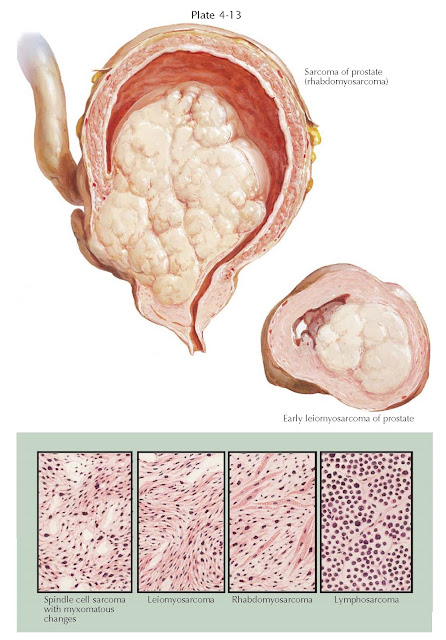SARCOMA OF PROSTATE
Sarcoma of the prostate is a rare cancer (0.1% of prostate malignancies), with most cases occurring in the first decade of life. Patients present with symptoms of urinary obstruction or hematuria, and there can be associated bowel symptoms of constipation, inability to defecate, or bloody stools. Sources of mesodermal tissue giving rise to sarcoma are connective tissue, striated and smooth muscle, and lymphatic or vascular structures. Although many cases remain unclassified, for practical purposes prostatic sarcomas may be grouped into the following categories.
Myosarcomas arise from either smooth or striated muscle elements and
comprise 50% to 60% of cases. Leiomyosarcomas are composed of interlacing
bundles of malignant smooth muscle cells. Rhabdomyosarcomas generally present
in childhood (mean age 5 years) and show cross and longitudinal striations
within the cytoplasm of striated muscle cells. They may exhibit extreme
pleomorphism in which spindle cells, round cells, and bizarre multinucleated
giant cells intermix. These tumors typically grow to a large size, projecting
into the bladder as a large nodular mass.
Malignant fibrous histiocytoma (MFH) occurs in 10% to 15% of cases and is
highly anaplastic, with marked pleomorphism. MFH is really more of a
morphologic pattern rather than a distinct pathologic entity. It is a synonym
for undifferentiated, pleomorphic sarcomas showing no specific line of
differentiation. Tumors in this group include storiform, angiomatoid, myxoid,
inflammatory, and giant cell sarcomas. A subset of pleomorphic MFH tumors
includes sarcomas that are termed unclassified as they resemble one or
more of the above histologic types.
Lymphosarcomas constitute 5% of prostatic sarcoma cases and originate from
the sparse lymphatics within the prostate. They contain mature and immature lymphocytes
that obscure the architecture and show a tendency to form lymphoid follicles.
Lymphomatous involvement of the prostate may also occur as a meta- static
manifestation of leukemia, Hodgkin disease, or lymphosarcoma originating
elsewhere in the body.
Carcinosarcoma of the prostate is rare and generally occurs in men
previously treated with androgen deprivation or radiation therapy for
adenocarcinoma of the prostate. It is a tumor that contains mixed elements of
adenocarcinoma and sarcoma and is very aggressive, with a 5-year survival of 50%.
Fibrosarcomas, originating from fibrous tissue and collagen, are most commonly
found in soft tissue of the extremities and bone but can be found in the
prostate. These include both spindle cell and round cell sarcomas, in which
myxomatous degeneration may be present.
Sarcomas of the prostate can invade the bladder wall, seminal vesicles,
and rectum, with obstruction to the bladder outlet and terminal ureters.
Symptoms in the adult are similar to those associated with benign prostatic
obstruction but progress within weeks or months to stranguria (straining to
urinate). In the infant, symptoms may mimic those of congenital urethral valves
or obstructive ureterocele. If urinary tract infection is superimposed on
obstruction, the symptoms may be accompanied by dysuria, frequency, and
hematuria. Regional spread to surrounding tissues is a constant feature, with
metastases to neighboring lymph nodes, abdominal viscera, and bone occurring
fairly early. Pain is not a characteristic early symptom but may be a salient
feature after the tumor has grown in size. Unlike prostatic carcinoma, sarcomas
do not cause an elevation of the serum acid
phosphatase.
Sarcoma may be suspected on rectal examination, as the prostate is
usually replaced by a rubbery mass that can be felt on rectal examination. The
diagnosis is established by either transrectal ultrasound–guided prostate
biopsy (see Plate 4-12) or by transurethral resection. The histologic type of
prostate sarcoma has prognostic significance, as pediatric patients with
rhabdomyosarcoma do better than those with other histologies, with a median
survival of more than 10 years. Tumor grade and tumor size are less relevant to
outcome. The presence of metastatic disease at
diagnosis is a uniformly poor prognostic marker.
The treatment of sarcoma of the prostate involves mainly surgical
extirpation. In the rare instance of early detection in which the disease is
still confined to the adult prostate, a radical prostatectomy is indicated. In
the infant, it is necessary to remove the prostate, seminal vesicles, and
bladder with diversion of the urinary stream. Multimodality therapy involving
chemotherapy and radiation therapy shows improved out-comes over surgery alone
with most sarcomas.





